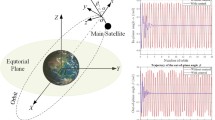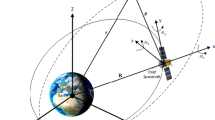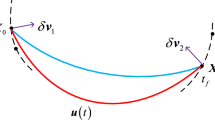Abstract
This paper studies the control of the geometric profile of a librating electrodynamic tether by model predictive control using the induced electric current in tether only. First, a high-fidelity multiphysics model of an electrodynamic tether system is built based on the nodal position finite element method and the orbital-motion-limited theory. Second, a state estimator is proposed to estimate the geometric profile of a librating electrodynamic tether, where only the positions and velocities at the tether ends are measurable. The non-measurable geometric profile of the tether between two ends is estimated by the high-fidelity multiphysics model with the input of the measurement at tether ends in the spatial domain. The extended Kalman filter is applied to estimate the geometric profile of the tether while avoiding the singularity or ambiguity in the estimation. Third, the geometric profile control of a librating electrodynamic tether is converted into a trajectory tracking problem of the underactuated electrodynamic tether system. The induced electric current in the tether is the only control input. Its value is optimized by the model predictive control method subject to the output and input control constraints. The numerical simulation results show that the proposed approach can effectively control the shape of the librating electrodynamic tether to the reference trajectory.












Similar content being viewed by others
Availability of data and material
Data sharing not applicable to this article as no datasets were generated or analyzed during the current study.
Code availability (software application or custom code)
The custom codes in the current study are available from the corresponding author on reasonable request.
References
Shan, M., Guo, J., Gill, E.: Review and comparison of active space debris capturing and removal methods. Prog. Aeosp. Sci. 80(January), 18–32 (2016). https://doi.org/10.1016/j.paerosci.2015.11.001
Sanmartin, J.R., Lorenzini, E.C., Martinez-Sanchez, M.: Electrodynamic tether applications and constraints. J. Spacecr. Rockets 47(3), 442–456 (2010). https://doi.org/10.2514/1.45352
Li, G., Zhu, Z.H.: Multiphysics finite element modeling of current generation of bare flexible electrodynamic tether. J. Propul. Power 33(2), 408–419 (2017). https://doi.org/10.2514/1.b36211
Li, G., Zhu Z.H.: Parameter influence on electron collection efficiency of a bare electrodynamic tether, Sci. China-Inf. Sci., 61(2), 022201:1–022201:12 (2017). https://doi.org/10.1007/s11432-017-9219-1.
Li, G., Zhu, Z.H., Ruel, S., Meguid, S.A.: Multiphysics elastodynamic finite element analysis of space debris deorbit stability and efficiency by electrodynamic tethers. Acta Astronaut. 137(August), 320–333 (2017). https://doi.org/10.1016/j.actaastro.2017.04.025
Corsi, J., Iess, L.: Stability and control of electrodynamic tethers for de-orbiting applications. Acta Astronaut. 48(5), 491–501 (2001). https://doi.org/10.1016/S0094-5765(01)00049-2
Williams, P.: Electrodynamic tethers under forced-current variations part II: flexible-tether estimation and control. J. Spacecr. Rockets 47(2), 320–333 (2010). https://doi.org/10.2514/1.45733
Wen, H., Yu, B., Jin, D.: Energy-based current control for stabilizing a flexible electrodynamic tether system. J. Beijing Inst. Technol. 60(1), 1–4 (2017). https://doi.org/10.15918/j.jbit1004-0579.201726.0101
Tortora, P., Somenzi, L., Iess, L., Licata, R.: Small mission design for testing in-orbit an electrodynamic tether deorbiting system. J. Spacecr. Rockets 43(4), 883–892 (2006). https://doi.org/10.2514/1.15359
Tragesser, S.G., San, H.: Orbital maneuvering with electrodynamic tethers. J. Guid. Control Dyn. 26(5), 805–810 (2003). https://doi.org/10.2514/2.5115
Li, G., Zhu, Z.H., Cain, J., Newland, F., Czekanski, A.: Libration control of bare electrodynamic tethers considering elastic–thermal–electrical coupling. J. Guid. Control Dyn. 39(3), 642–654 (2016). https://doi.org/10.2514/1.g001338
Li, G., Zhu, Z.H.: Estimation of flexible space tether state based on end measurement by finite element Kalman filter state estimator. Adv. Space Res. 67(10), 3282–3293 (2021). https://doi.org/10.1016/j.asr.2021.01.057
Sanmartin, J.R., Martinez-Sanchez, M., Ahedo, E.: Bare wire anodes for electrodynamic tethers. J. Propul. Power 9(3), 353–360 (1993). https://doi.org/10.2514/3.23629
Li, G., Zhu, Z.H., Meguid, S.A.: Libration and transverse dynamic stability control of flexible bare electrodynamic tether systems in satellite deorbit. Aerosp. Sci. Technol. 49, 112–129 (2016). https://doi.org/10.1016/j.ast.2015.11.036
Wang, C., Li, G., Zhu, Z.H., Li, A.: Mass ratio of electrodynamic tether to spacecraft on deorbit stability and efficiency. J. Guid. Control Dyn. 39(9), 2192–2198 (2016). https://doi.org/10.2514/1.g000429
Sun, F.J., Zhu, Z.H., LaRosa, M.: Dynamic modeling of cable towed body using nodal position finite element method. Ocean Eng. 38(4), 529–540 (2011). https://doi.org/10.1016/j.oceaneng.2010.11.016
Li, G.Q., Zhu, Z.H.: Long-term dynamic modeling of tethered spacecraft using nodal position finite element method and symplectic integration. Celest. Mech. Dyn. Astron. 123(4), 363–386 (2015). https://doi.org/10.1007/s10569-015-9640-5
Li, G., Zhu, Z.H.: Precise analysis of deorbiting by electrodynamic tethers using coupled multiphysics finite elements. J. Guid. Control Dyn. 40(12), 3348–3357 (2017). https://doi.org/10.2514/1.g002738
Reif, K., Unbehauen, R.: The extended Kalman filter as an exponential observer for nonlinear systems. IEEE Trans. Signal Process. 47(8), 2324–2328 (1999). https://doi.org/10.1109/78.774779
Babacan, E.K., Ozbek, L., Efe, M.: Stability of the extended Kalman filter when the states are constrained. IEEE Trans. Autom. Control 53(11), 2707–2711 (2008). https://doi.org/10.1109/TAC.2008.2008333
Sun, X., Zhang, H., Cai, Y., Wang, S., Chen, L.: Hybrid modeling and predictive control of intelligent vehicle longitudinal velocity considering nonlinear tire dynamics. Nonlinear Dyn. 97(2), 1051–1066 (2019). https://doi.org/10.1007/s11071-019-05030-5
Williams, R.L., Lawrence D.A.: Linear state-space control systems, Wiley Online Library, pp 174–176, (2007).
van de Walle, A., Naets, F., Desmet, W.: Virtual microphone sensing through vibro-acoustic modelling and Kalman filtering. Mech. Syst. Signal Proc. 104(May), 120–133 (2018). https://doi.org/10.1016/j.ymssp.2017.08.032
Franchi, L., Feruglio, L., Mozzillo, R., Corpino, S.: Model predictive and reallocation problem for CubeSat fault recovery and attitude control. Mech. Syst. Signal Proc. 98(January), 1034–1055 (2018). https://doi.org/10.1016/j.ymssp.2017.05.039
Li, P., Zhu, Z.H.: Line-of-sight nonlinear model predictive control for autonomous rendezvous in elliptical orbit. Aerosp. Sci. Technol. 69(October), 236–243 (2017). https://doi.org/10.1016/j.ast.2017.06.030
Zhu, M., Chen, H., Xiong, G.: A model predictive speed tracking control approach for autonomous ground vehicles. Mech. Syst. Signal Proc. 87(March), 138–152 (2017). https://doi.org/10.1016/j.ymssp.2016.03.003
Zhang, P., Wu, Z., Meng, Y., Tan, M., Yu, J.: Nonlinear model predictive position control for a tail-actuated robotic fish. Nonlinear Dyn. 101(4), 2235–2247 (2020). https://doi.org/10.1007/s11071-020-05963-2
Sidje, R.B.: Expokit: A software package for computing matrix exponentials. ACM Trans. Math. Softw. (TOMS) 24(1), 130–156 (1998). https://doi.org/10.1145/285861.285868
Kassaeiyan, P., Tarvirdizadeh, B., Alipour, K.: Control of tractor-trailer wheeled robots considering self-collision effect and actuator saturation limitations. Mech. Syst. Signal Proc. 127(July), 388–411 (2019). https://doi.org/10.1016/j.ymssp.2019.03.016
Li, D., Cao, H., Zhang, X., Chen, X., Yan, R.: Model predictive control based active chatter control in milling process. Mech. Syst. Signal Proc. 128(August), 266–281 (2019). https://doi.org/10.1016/j.ymssp.2019.03.047
Haghighat, S., Liu, H.H.T., Martins, J.R.R.A.: Model-predictive gust load alleviation controller for a highly flexible aircraft. J. Guid. Control Dyn. 35(6), 1751–1766 (2012). https://doi.org/10.2514/1.57013
Rawlings, J.B., Mayne, D.Q., Diehl, M.: Model predictive control: theory, computation, and design. Nob Hill Publishing Madison, WI (2017)
Zong, L., Luo, J., Wang, M., Yuan, J.: Obstacle avoidance handling and mixed integer predictive control for space robots. Adv. Space Res. 61(8), 1997–2009 (2018). https://doi.org/10.1016/j.asr.2018.01.025
Wen, H., Jin, D.: De-spinning of tethered space target via partially invariable deployment with tension control. Nonlinear Dyn. 96(1), 637–645 (2019). https://doi.org/10.1007/s11071-019-04811-2
Wen, H., Zhu, Z.H., Jin, D., Hu, H.: Model predictive control with output feedback for a deorbiting electrodynamic tether system. J. Guid. Control Dyn. 39(6), 2451–2456 (2016). https://doi.org/10.2514/1.G000535
Li, P., Zhu, Z.H.: Model predictive control for spacecraft rendezvous in elliptical orbit. Acta Astronaut. 146(May), 339–348 (2018). https://doi.org/10.1016/j.actaastro.2018.03.025
Funding
This work is supported by the Discovery Grant (RGPIN-2018–05991) and Discovery Accelerator Supplements Grant (RGPAS-2018–522709) of Natural Sciences and Engineering Research Council of Canada.
Author information
Authors and Affiliations
Contributions
Dr. Gangqiang Li was the co-investigator of the project, conducted formal analysis and methodology development, coding, data analysis, and draft writing. Dr. Zheng H. Zhu was the principal investigator of the project, led the conceptualization and methodology development, formal analysis, acquired funding, project administration, and writing and editing of paper.
Corresponding author
Ethics declarations
Conflict of interest
The authors declare no conflict of interest in this article.
Additional information
Publisher's Note
Springer Nature remains neutral with regard to jurisdictional claims in published maps and institutional affiliations.
Rights and permissions
About this article
Cite this article
Li, G., Zhu, Z.H. Model predictive control for electrodynamic tether geometric profile in orbital maneuvering with finite element state estimator. Nonlinear Dyn 106, 473–489 (2021). https://doi.org/10.1007/s11071-021-06869-3
Received:
Accepted:
Published:
Issue Date:
DOI: https://doi.org/10.1007/s11071-021-06869-3




